

10 Critical Leadership Battles (And How You Can Win Them All) 6 ways to use social media to connect with parents. Social media can be a powerful tool to coordinate and connect with parents.
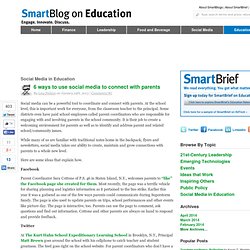
At the school level, this is important work for everyone, from the classroom teacher to the principal. Some districts even have paid school employees called parent coordinators who are responsible for engaging with and involving parents in the school community. It is their job to create a welcoming environment for parents as well as to identify and address parent and related school/community issues. While many of us are familiar with traditional notes home in the backpack, flyers and newsletters, social media takes our ability to create, maintain and grow connections with parents to a whole new level. Here are some ideas that explain how. Facebook Parent Coordinator Sara Cottone of P.S. 46 in Staten Island, N.Y., welcomes parents to “like” the Facebook page she created for them. Twitter Blogger Technology teacher Mr. Tumblr Pruchnicky also invites parents to participate in their child’s learning.
YouTube. Three Ways Teacher Leaders Support School Improvement - Hillsborough, NC. When You Fail, I Fail – Approach To Leadership. As school leaders, we must realize we are in this together.
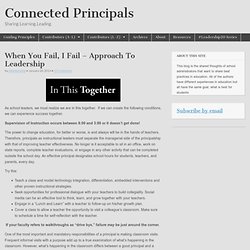
If we can create the following conditions, we can experience success together. Supervision of Instruction occurs between 8:00 and 3:00 or it doesn’t get done! The power to change education, for better or worse, is and always will be in the hands of teachers. Therefore, principals as instructional leaders must separate the managerial side of the principalship with that of improving teacher effectiveness. No longer is it acceptable to sit in an office, work on state reports, complete teacher evaluations, or engage in any other activity that can be completed outside the school day.
Try this: Teach a class and model technology integration, differentiation, embedded interventions and other proven instructional strategies.Seek opportunities for professional dialogue with your teachers to build collegiality. Should Principals Stop Visiting Classrooms? NO.
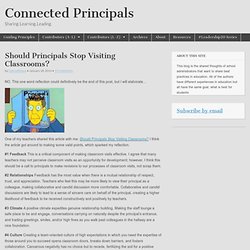
This one word reflection could definitively be the end of this post, but I will elaborate… One of my teachers shared this article with me: Should Principals Stop Visiting Classrooms? I think the article got around to making some valid points, which sparked my reflection. #1 Feedback This is a critical component of making classroom visits effective. John Hattie on School Leadership. Show me your effect size!

Last week I transcribed a short video of a speech by Dylan Wiliam that celebrated the magnificently complex vocation that is teaching and how every teacher can improve – see here. At a similar time to watching the Dylan Wiliam video, and finding it struck a resonant chord, I read transcript of a speech given by John Hattie to school leaders in Auckland, New Zealand in 2002. John Hattie is now widely known for his seminal research undertaken for his data rich tome ‘Visible Learning‘, but this speech wasn’t known to me. The First Year: 10 Tips for New Principals - Ferndale, MI. By the time they step into the position, most principals have already spent years—even decades—in the classroom as teachers.

This experience certainly comes in handy, but rarely is it enough to keep new principals from being broadsided by new challenges. While experience is often the best teacher, we’d like to help new principals avoid common first-year blunders by sharing 10 tips from 20-year veteran principal, Jan Borelli. Learn to distinguish between alliance and friendship Indeed, teachers thrive when they have the support of their principal. SmartBlog on Education - Taking the fork for a change by @dillon_jim via SmartBlogs. “When you come to a fork in the road, take it.” — attributed to Yogi Berra When I was a principal, standing in front of the staff with any proposed change to present, felt like standing before a fork in the road.

I was reluctant to put anything more on their plates, but I also wanted to make positive changes in the school. I finally learned that neither backing off or charging ahead with the proposed change would suffice. Instead I figured out what the “fork” was and how I had to take it, if I wanted to connect with the staff and facilitate positive change. The “fork” is the conflicting, often contradictory mindsets that educators present back to any principal or administrator presenting to them: Educational Leadership - April 2013 - Page 66. The Principalship:Be a Cage-Buster. Frederick M.
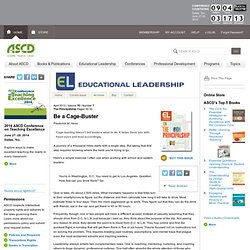
Hess You're in Washington, D.C. You need to get to Los Angeles. Why Would Anyone Want To Be a School Leader? - Finding Common Ground. 5 Characteristics of a Change Agent. Cc licensed ( BY ) flickr photo shared by visualpanic (change agents) – People who act as catalysts for change… In my work through school and organization visits, I have been fascinated to see the correlation between the speed of change and an individual who is “leading” the charge.

The schools that have someone (or a group of people) helping to push the boundaries of what can be done in schools seem to move a lot quicker with a larger amount of “buy-in” through the process. As Malcom Gladwell describes in his book, “The Tipping Point“, he states: The success of any kind of social epidemic is heavily dependent on the involvement of people with a particular and rare set of social gifts. Although Gladwell talks about the “Law of the Few” (connectors, mavens, salesman), I do not believe change is solely dependent upon their skills, but also the culture in which they exist. Giving Feedback - The Art of Coaching Teachers. UserID: iCustID: IsLogged: false IsSiteLicense: false UserType: anonymous DisplayName:

Your climate, your culture SmartBlogs. The climate and the culture of your school are not the same thing.
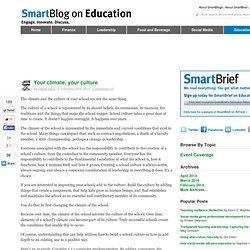
The culture of a school is represented by its shared beliefs, its ceremonies, its nuances, the traditions and the things that make the school unique. School culture takes a great deal of time to create. It doesn’t happen overnight. The Karate Studio: An Excellent Example of a Competency-Based Classroom. Master Ocasio With Brady and Cameron Stack At least twice a week I have the opportunity to do a formal observation of the karate instructors that help my wife Erica and my two oldest boys, Brady (7) and Cameron (5), as they work towards their black belts. There are so many parallels between how their karate classes are structured and how we as administrators would like to see our teachers structure their twenty-first century competency-based classrooms. PDE Principal Evaluation ePortfolio Template. The First Days. Do you remember your first day as an administrator? I certainly do.
I was one of two rookies VPs placed at a brand new school. The New Ed-Tech Leader Models by Digital Example. 4 Attributes of a Great Assistant Principal. Cc licensed ( BY ) flickr photo shared by Big Mind Zen Center. 8 Things to Look for in Today’s Classroom. Cc licensed ( BY ) flickr photo shared by chrisbb@prodigy.net As I think that leaders should be able to describe what they are looking for in schools I have thought of eight things that I really want to see in today's classroom. I really believe that classrooms need to be learner focused. This is not simply that students are creating but that they are also having opportunities to follow their interests and explore passions. The teacher should embody learning as well. The Modern Day Multilingual Principal. “One of the most difficult organization’s to lead and create deep change within is education and school…since everyone has been through it, everyone believes they know best on how it should be done and look.”
Changing the culture of a school and be a very traumatic and difficult proposition. Especially when trying to implement anything that is different or cutting edge. Whether that be technology, strategies, structures, systems, or the environment. But why? An easy answer to the difficulty of the change in school comes in two parts; time and stakeholders. Let’s tackle time, first. Second, very few, if any, other organizations have as many stakeholders that schools and school leaders are beholden too. Teacher Collaboration: When Belief Systems Collide. Your School Year in Numbers. The principal-leader checklist. The role of the building principal continues to change at the pace of a whitewater current. In order to support teachers and student achievement in 2013 and beyond, the principal-leader will need to have a clear understanding of his or her role.
Leadership books address vision, management, empowerment, modeling, coaching, rewarding and strategic planning. Digital Leadership Defined. When I looked up the term “digital citizenship”, the first definition that I found was the following: …teaching users the rules of good citizenship online; this usually includes email ettiquette, protecting private information, staying safe online, and how to deal with bullying, whether you’re a target or a bystander. For the past couple of years, I have been really focusing on the notion of digital leadership, and although I have not seen a formal definition of what that would mean, I would like to think of it as this: Using the vast reach of technology (especially the use of social media) to improve the lives, well-being, and circumstances of others.
3 Things That Need To Be Reciprocated in Schools. Fair Isn’t Equal: Seven Classroom Tips. In last month's post, I mentioned that there are two skills that separate great teachers from good ones. I explained that the first skill is the ability to reframe student behavior, to see it in new ways. Schools Are Using Social Networking to Involve Parents. Bullying Prevention: Tips for Teachers, Principals, and Parents. Updated 10/2013. Lincoln High School in Walla Walla, WA, tries new approach to school discipline — suspensions drop 85% « ACEs Too High. Helping teachers to develop safer schools and prevent school violence. Motivation From Within: Moving Away From Awards, Rewards, Punishment.
Resources to Fight Bullying and Harassment at School. A guide to websites, organizations, articles, and other resources for combating bullying. Dealing with Students Who Bully: Part I (The Essential First Step) Dealing With Students Who Bully: Part II. What Are we Measuring in Education? Don't Evaluate Teachers, Coach Them - Coach G's Teaching Tips. October 3, 2012. The Wejr Board. Pam Lowe: Top 10 Ways to Improve Student Achievement and Create Learners. Principal Leadership - Priority One! - Cedar Hill, TX. Meaningful Staff Meetings. Recognize The Big Rocks. Knowing our blind spots. 6 Ways Principals Can Connect With Students. Why Public School Leaders Must Embrace Social Media Now. 7 Habits of Highly Effective Tech-leading Principals.
iPad Apps for Administrators. 7 Steps To Effective Feedback. 20 Education Administrator Blogs You Should Start Following Right Now. Are You a Steward of Time? 2 things everyone wants SmartBlogs. An Open Letter to Principals: Five Leadership Strategies for the New Year. Leading innovative & transformative change: 5 key considerations. Becoming an innovative school? My top 10 ideas. Building Capacity for a Learning Community. 15 Tips for the New Principal. 5 Ways to Build Sustainable Relationships within Your School - John Wilson Unleashed.
The principal perspective: full report. 9 Suggestions for the Welcome Back to School letter from the Principal. 4 Ways We Can Connect With Parents. Getting Started with Informal Classroom Walkthroughs.